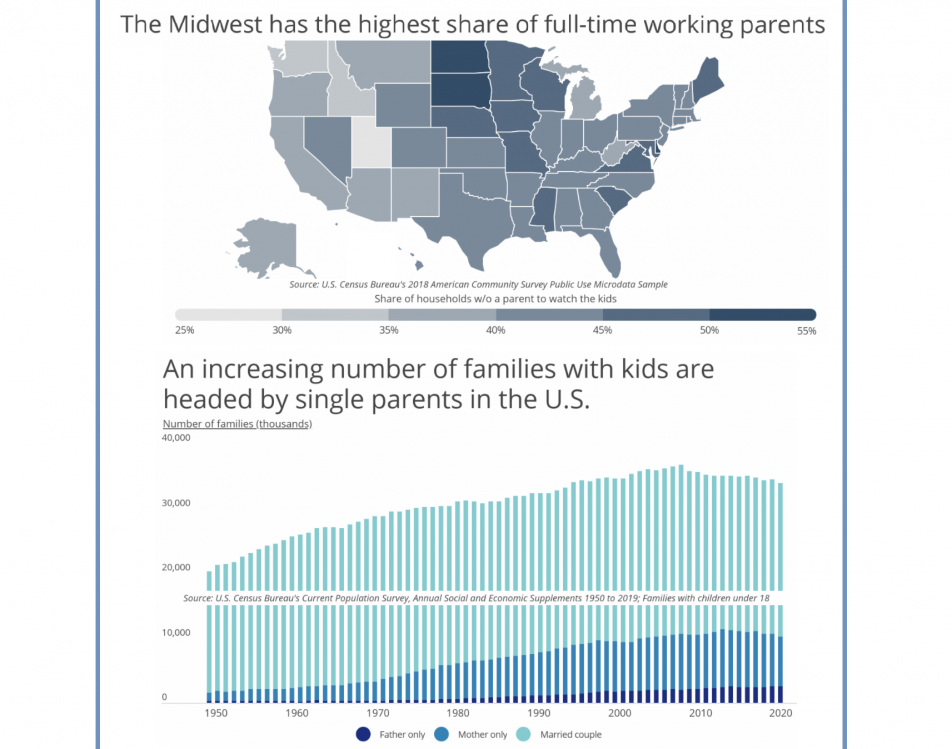As the fall quickly approaches, schools around the country are grappling with the best way to operate safely during the COVID-19 pandemic. Many school districts will start the year virtually, while others will open with a hybrid approach that combines face-to-face instruction with online learning. Even in areas where schools are open fully, many families will choose remote learning for their kids. Regardless of the specifics, millions of American children will spend at least some of their time learning from home this year.
According to the Pew Research Center, stay-at-home moms and dads account for about one-fifth of U.S. parents, meaning 80 percent of parents are employed either full time or part time. When considering households with children under 14 (the oldest minimum age a child can legally be left alone in any of the U.S. states), Census data shows that over 40 percent of families potentially lack an available parent to supervise the kids in the event of school closures. This means that as of 2018 (the most recent Census data release) either both parents worked full time in two-parent families or the one parent worked full time in single-parent families.
The number of single parents has climbed steadily since 1950, and these parents are more likely to work full time than those in married or cohabiting-couple households. Among single-parent households with children under 14 years old, 57 percent have a full-time working parent. Among two-parent households, just 37 percent have both parents working full time. Although many people now work from home due to the pandemic, juggling work while supervising children is no easy feat. Families with a non-full-time working parent are better positioned to handle the school year; whereas, those without will face unprecedented challenges.
The share of families potentially lacking an available parent to supervise the kids varies widely across cities and states. At the state level, many Midwestern states have large proportions of households with full-time working parents. South Dakota and Delaware have the biggest share of households with full-time working parents at 52.9 and 52.4 percent, respectively. Conversely, many families in Utah and Idaho will not struggle as much with school closures and remote learning. The share of households with full-time working parents in these states is low, at 28.7 and 33.6 percent, respectively.
To find the states with the most full-time working parents (i.e. the fewest non-full-time working parents), researchers at Smartest Dollar, a review site for financial products and services, analyzed the latest data from the U.S. Census Bureau. The researchers ranked states according to the share of households with children under 14 that potentially lack a parent to watch the kids (defined as either both parents working full time in two-parent families or the one parent working full time in single-parent families). Researchers also calculated the number of married-couple households with both parents working, the number of single-parent households with a working parent, and the total number of households with kids under 14.
This analysis found that in Tennessee, 41.4% of households with kids under 14 years old may not have a parent at home to watch them when school starts. Here is a summary of the data for Tennessee:
- Share of households without a parent to watch the kids: 41.4%
- Married-couple households with both parents working: 146,572
- Single-parent households with a working parent: 74,684
- Total households with kids under 14: 533,831
- Average number of kids under 14 per household: 1.8
For reference, here are the statistics for the entire United States:
- Share of households without a parent to watch the kids: 41.5%
- Married-couple households with both parents working: 7,460,793
- Single-parent households with a working parent: 3,228,009
- Total households with kids under 14: 25,749,434
- Average number of kids under 14 per household: 1.8
For more information, a detailed methodology, and complete results, you can find the original report on Smartest Dollar’s website: https://smartestdollar.com/


